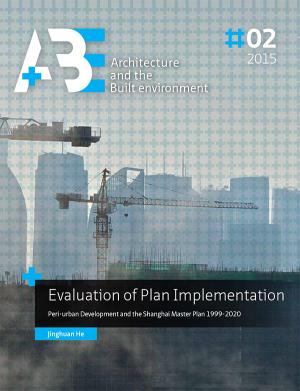Hosted by
Evaluation of Plan Implementation: Peri-urban Development and the Shanghai Master Plan 1999-2020
Synopsis
Since the 1980s China has experienced unprecedented urbanisation as a result of a series of reforms promoting rapid economic development. Shanghai, like the other big cities along China’s coastline, has witnessed extraordinary growth in its economy and population with industrial development and rural-to-urban migration generating extensive urban expansion. Shanghai’s GDP growth rate has been over 10 per cent for more than 15 years. Its population in 2013 was estimated at 23.47 million, which is double its size in 1979. The urban area enlarged by four times from 644 to 2,860 km2 between 1977 and 2010.
Such demanding growth and dramatic changes present big challenges for urban planning practice in Shanghai. Plans have not kept up with development and the mismatch between the proposals in plans and the actual spatial development has gradually increased, reaching a critical level since 2000. The mismatch in the periurban areas is more notable than that in the existing urban area, but there has not been a systematic review of the relationship between plan and implementation. Indeed, there are few studies on the evaluation of plan implementation in China generally. Although many plans at numerous spatial levels are successively prepared and revised, only few of them have been evaluated in terms of their effectiveness and implementation.
This particularly demanding context for planning where spatial development becomes increasingly unpredictable and more difficult to influence presents an opportunity to investigate the role of plans under conditions of rapid urbanisation. The research project asks to what extent have spatial plans influenced the actual spatial development in the peri-urban areas of Shanghai? The research pays particular attention to the role of the Shanghai Master Plan 1999-2020 (Plan 1999). By answering the main research question this study seeks to contribute to a better understanding of present planning practice in Shanghai from a plan implementation perspective, and to establish an analytical framework for the study of the role of plans that fits the Chinese context. The findings may also help planners, policy makers and private developers to adjust urban planning within the implementation process in order to meet planning objectives at different levels.
The evaluation of plan implementation can be divided into peformance-based and performance-based approaches Conformance approaches focus on the direct linkage (i.e. level of conformity) between the plans and spatial outputs (Laurian et al., 2004; Tian & Shen, 2011). Performance approaches are concerned more with outcomes and the role of the plan in the urban development process (Barrett & Fudge, 1981; Faludi, 2000). Both of these approaches are employed in this research to evaluate the implementation of the Plan 1999. I firstly examine the level of conformity between the Plan 1999 and the overall peri-urban structure at the metropolitan level. I then use examples of specific areas (North Jinqiao Export Processing Zone and Xinmin Development Area) to evaluate performance of the Plan 1999.
The study also takes a diachronic approach, which looks at how relationships between variables change over time in the implementation of the Plan 1999. That is because the performance of plans is influenced by deeper-seated reasons such as the changing institutional context, particularly the levels of interaction between involved actors in the land development processes. As such, the changing planning system in Shanghai and the history of Shanghai’s peri-urban development in the second half of the 20th century are reviewed before the conformance-based and performance-based evaluation.
This research leads to three major findings. First, peri-urban areas have played an increasingly important role in Shanghai’s urbanisation process through accommodating the rapidly increasing population and demands for growth. Such extensive peri-urban development was not guided by the Plan 1999. It is not surprising that plans are left behind in the context of such unprecedented growth, but the pilot programmes and the key projects proposed in the Plan 1999 were implemented with a high level of conformance. However, the Plan 1999 performed differently in local urban projects, with varying degrees of project conformity, development process and development timing.
Second, there was variation in the delivery of the main objectives to the subsequent urban plans, the consistency between the Plan 1999 and the related sector plans, the ways of interaction between involved actors and their reactions to the plan, and the methods of land development. Overall, the Plan 1999 performed better in the case of North Jinqiao Export Processing Zone because the governments (at both national and municipal levels) intervened more in the development process, compared with the case of Xinmin Development Area. The performance of the plan is closely related to the level of conformity between the plan and the actual development. Therefore, although the conformance-based and performance-based approaches to implementation can be separated conceptually, they are very interconnected in practice.
Third, the urban planning system in Shanghai has experienced a structural reorganization in terms of the system of plans, the involved actors and the planning instruments since the late 1980s. But the emphasis on the rational technocratic process used in the 1960s in the western society is still predominant in the planning system in Shanghai. Aside from the demanding urban growth, the other reason of non-conformance between the actual peri-urban development and the Plan 1999 and bad performance of the Plan 1999 in local projects is a big gap between the seemingly rational operation of the urban planning system and the reality of external challenges.
The current planning system lacks proper coordination with the external challenges, such as insufficient investigation of the existing circumstance or history, and ineffective planning instruments. Cooperation between involved actors is also largely absent in planning practice. Overall, urban planning and management in Shanghai could benefit from more recognition and monitoring of plan implementation which would lead to some reconsideration of the planning tools and processes to more effectively guide future urban development.

